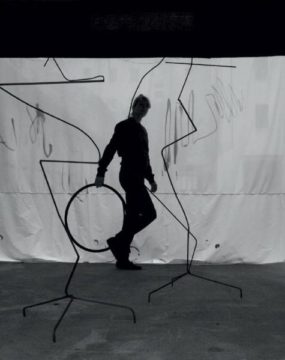Eigens für Reutlingen hat Kalin Lindena (geb. 1977), jüngst als Professorin an die Karlsruher Akademie berufen, einen choreografischen Parcours gestaltet, der den Kunstverein zum Schauplatz einer weitläufigen Installation macht: mit halbtransparenten Vorhängen stattet sie 500 qm der lichten und freitragenden Halle aus und verwandelt diese in eine farbrauschende Bühne.
Ausgang dafür ist Hans Jantzens am Kirchenfenster entwickelter Begriff der durchscheinenden oder „diaphanen Struktur“, der augenscheinlich macht, dass die farbige Durchlichtung, die in gotischen Buntglasfenstern oder eben in Lindenas Vorhangstoffen steckt, Innen- und Außenraum, das Nahe und das Ferne, Kunst und Lebenswelt, selbst Irdisches und Himmlisches als ein notwendig zusammengehöriges und sich wechselseitig erhellendes „Kontinuum“ in sich vereint.
Die Ausstellungsfläche wird so zu einem Auftrittsort: nicht allein für Lindenas abstrakte Stahlplastiken, die sie mit filigran zeichnerischer Geste gibt und spielerisch verteilt an verschiedenen Stellen im Raum auftauchen lässt, sondern gerade auch für uns. Schon beim Betreten der Ausstellungshalle befinden wir uns inmitten ihrer „Statisten“, so nennt sie diese Plastiken, die uns unmittelbar auffordern, die „statische“ Betrachterposition zu verlassen und auf der gegebenen Raumbühne selbst zu Protagonisten zu werden.
Denn in ihrer scheinbaren Statik greifen Lindenas Figuren über sich hinaus, treten hinüber in unsere Daseinssphäre und laden uns ein, den Möglichkeitsraum, den die Ausstellung schafft, auf eigenen Wegen zu erkunden und unseren Ort darin zu finden.
Der reich illustrierte und großzügig gestaltete Katalog zeigt den ausschweifend weiten Ausstellungsparcours und nähert sich dem vielgestaltig installativen, zeichnerischen und performativen Schaffen von Kalin Lindena durch Gegenüberstellungen mit Oskar Schlemmer, Paul Scheerbart, Hilma af Klingt und Carl Gustav Jung sowie mit Stéphane Mallarmé, Edgar Degas oder Paul Valéry in den einsichtsvollen Texten von Susanne Kaufmann (Staatsgalerie Stuttgart), Lina Launhardt (Autorin und freie Kuratorin, Berlin).
Especially for Reutlingen Kalin Lindena (born 1977), appointed professor at the Karlsruhe Academy just recently, has created a choreographic course which turns the Kunstverein into the scene of an abundant installation: she provides it with semi-transparent curtains which transform 500 sqm of the bright and cantilever hall into a colour-glittering stage.
The vantage point for this is Hans Jantzen’s term of the translucent or “diaphane structure” which he formed surveying ecclesiastical glass-windows in order to demonstrate that the colourful translucence, inherent in the gothic stained glass windows or in Lindena’s very fabrics, unifies within itself interior and exterior space, the near and the far, art and life, even the mundane and the celestial as a necessarily associated and reciprocally elucidated “continuum”.
Thus, the exhibition space really turns it into a place of appearance: not only for Lindena’s abstract steel-sculptures, wielded with a delicately graphical gesture and playfully dispersed throughout the space, but most notably for us. As soon as we enter the exhibition hall we are amidst her “Statisten”, her “Extras” as she calls these sculptures, which immediately prompt us to abandon the “static” position of a beholder and become protagonists ourselves upon the stage of the given space.
In their alleged statics, Lindena’s figures extend beyond themselves, transgress into our sphere of being, and invite us to explore the space of possibilities her exhibition creates on our own paths and to attain our particular places amidst it.
The richly illustrated and lavishly designed catalogue presents the intricate course of the exhibition and approaches the manifold, installational, graphical, and performative œuvre of Kalin Lindena by comparisons with Oskar Schlemmer, Paul Scheerbart, Hilma af Klint, and Carl Gustav Jung as well as with Stéphane Mallarmé, Edgar Degas, or Paul Valéry in the comprehensive texts of Susanne Kaufmann (Staatsgalerie Stuttgart) and Lina Launhardt (author and independent curator, Berlin).
- Veröffentlicht am Montag 20. Juli 2015 von Wasmuth, E
- ISBN: 9783803033741
- 64 Seiten
- Genre: Bildende Kunst, Kunst, Literatur, Sachbücher
